Rune vs Draper: Indian Wells Final Recap
the heavy ball — unreturned serves — serving — elo ratings
Jack Draper defeated Holger Rune 6/2 6/2 to clinch his maiden Masters 1000 title and a spot in the ATP top-10 for the first time in his career (debuting at #7, and with very little to defend through the clay season). He also levels his H2H against Rune at 1-1.
First Set
Draper’s M.O. all week has been using the height and heavy topspin of his lefty forehand to kick the ball up into uncomfortable regions of the strike zone for right handers. I thought he did that well against Fonseca in the second round especially, averaging over 96 centimetres over the net on his forehand rally ball for that match. On the gritty Indian Wells surface and light desert air, handling such topspin is no easy feat. A look at the four winners from the last five years has them all as very heavy topspin players:

Perhaps in a bid to smother the Draper forehand, the opening exchanges saw Rune look to get on top of Draper’s forehand, holding the baseline and taking the ball on the rise:
The Dane has a compact forehand setup suited for taking the ball early, but I think it can be too compact for certain situations.
Draper’s forehand at Indian Wells this week was just such a situation; taking on such a heavily spun forehand on the rise isn’t easy. The timing and racquet speed has to be elite, given that Draper has been averaging ~3300 rpm on the forehand this week, which is as heavy as it gets.
At 30-30 in Rune’s opening service game the Dane got caught flat-footed on the baseline and attempted to hit a heavy Draper forehand on the rise, tamely returning it to the mid-court, which the Brit promptly ran around and dispatched for a forced error off his own forehand.
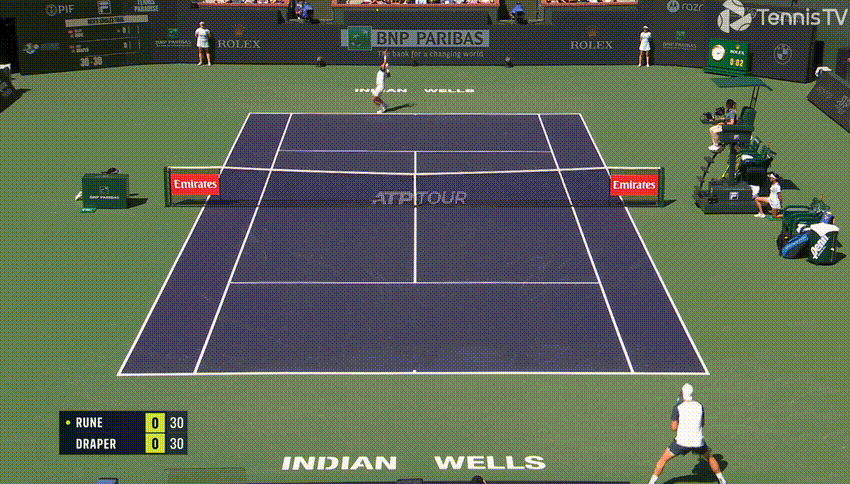
Topspin and the “heavy ball” is labeled as such because it requires more racquet head speed to reverse the spin of the incoming shot (relative to a flatter incoming ball) if the other player wishes to also hit with topspin. There is rotational energy in the ball that has to be overcome, as well as frictional forces between the ball and strings, and these forces exert themselves on the racquet. This is why comparing two players’ shot speeds is almost useless without also knowing their topspin rates. On a court like Indian Wells, it also means having to deal with such heaviness from sub-optimal contact points above the shoulder.
“He’s [Rune] struggling a little with the height of the bounce. It’s a hotter day, really lively, and the way Draper’s hitting the ball, you know, he’s ripping the topspin — it’s not just about speed — and you can see him [Rune] actually say to Lars Christensen ‘this ball’s jumping up so high, it’s above my shoulders, it’s above my head sometimes.’”
— Tennis TV
Hitting a heavy topspin shot on the rise is further made difficult by the “kick” or extra zip that the ball appears to have after the bounce, making timing harder. And you can’t slow the racquet head down, quite the opposite, in fact. The physics is such that a ball can actually come off the the same rising racquet angle with either topspin or backspin, depending on the racquet’s path speed relative to the ball.

For an illustration of how a closed racquet face and upward moving racquet can still produce backspin, look at this Alcaraz half volley from his Madrid match against Ruusuvuori in 2023.
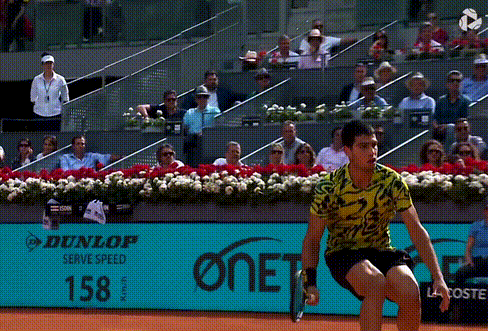
But this post is about Jack Draper dammit.
I first wrote a match recap of Draper last year following his Vienna title, and much of what made me bullish six months ago was only appearing more obvious now. Some excerpts:
…there’s just a lot of things Draper does well. Movement? Great. Serve? Lefty and nasty. Backhand? It’s flat and punchy and well-suited to today’s fast-paced game…
The forehand is consistent without doing an elite amount of damage, but there are signs that the pace is there when he is willing to be more aggressive… The end-range danger on the forehand — a sore point of so many prospects — is actually pretty good with Draper.
At Indian Wells the forehand was doing elite damage; a nasty left hook that delivered body blow after body blow.
There were alarm bells pretty early in this match for Rune. The Dane had opened his account by getting broken, having tried to attack the Draper forehand. Then down 0-2 15-30, Rune played a patient crosscourt rally with the Draper backhand, but he found no reprieve there, the Brit staying rock solid with his flat backhand cross — again into Rune’s forehand — before rapidly backpedaling to find a forehand which he smoked inside-in. Draper would go on to earn the insurance break.
In the first point of the 3-0 game Rune again found some relief trading his forehand more patiently and with more margin into the Draper backhand. It was a well structured point that was ended with his heavyweight two-hander stepping on a weaker Draper forehand on the run.
But Rune’s rally problems weren’t even the main issue. Draper’s serve was deadly throughout this encounter, with a whopping 58% (!) of serves going unreturned. From 0-15 down, the rest of the 3-0 game above went: ace, plus-one forced error, ace, ace. The first-serve stats for the match:
There’s often a zero or one-hundred speed to Rune’s game at times — the forehand especially. At heart I feel he is a counterpuncher — especially in big moments — but often he takes on points with a premeditated big swingin’ air to vent his frustration, like this point at 4-0 break point. What was there to lose?
Rune would hold for his first game.
The Dane got a look at a second serve on the opening point at 1-4 down, and for a guy who has an excellent crush-and-rush, he was not doing nearly enough to trouble Draper:

And that was the let down for Rune in this first set. His best shots and aggressive intentions were when he was already way out of the set (like when serving at 1-5). Glimpses of potential in hopeless games.
At 5-2 Draper lost the first point of the game, as he did in the 3-0 game, and Rune did well to hustle his way to 30, but again Draper found two aces and an unreturnable to hold for the first set 6-2.
Second Set
If the tennis scoring system and their accompanying changeovers are meant to disrupt momentum, no one told Jack Draper. Perhaps that was just a sign that the Brit was all too comfortable executing his strategy in these conditions. He went straight back to work in Rune’s opening service game, finding extreme height and spin on his second-serve forehand returns:

The Dane’s discomfort was not just evident in the screams of frustration to his box, these rash forehands from behind the baseline were Hail Mary’s.
Mirroring the first set, Draper broke Rune’s opening game and quickly held to 15 to put the pressure back on the Dane, who was battling to get on the scoreboard.
Sealing his first game of the second set required a flurry of forehands from inside the baseline, with Draper showcasing his defensive skills from the corners. The guy is an athlete.
At this point we got a graphic of Draper’s shot placement, which was heavily focused on pressuring Rune’s forehand, despite the typical lefty play in such conditions.
In fact, Draper would finish with 51% of his forehands going down the line, into the Rune forehand, rather than crosscourt. But on top of changing directions more often, Draper was also hitting his forehand faster and with more spin:
Rafa would be impressed.
It must be said that Rune didn’t play well. How much of that was Draper, and how much was simply Rune not managing the occasion is up for discussion. Certainly Draper was the aggressor and had a clear strategy, but even the most basic of returns were often missed, like this second-serve chance at the beginning of the 2-3 game, which Holger paddled into the net from some five metres behind the baseline:
It was the forehand that let Rune down serving at 2-4 as well. Twice flattening out the inside-out forehand long in a manner similar to his opening service game of the match. That shot did not fire at all today.
On an unrelated note, Draper was making himself cross-eyed on the changeover before the biggest hold of his life.
I’m not sure how it affected his vision, but his coach, James Trotman, shouted some simple messages of “legs and forehand” before this 30-0 point:
Draper held at 40-15 to secure his maiden 1000 title.
Tennis Insights dropped the forehand leaderboard for the event:
Draper was fifth on Tennis Abstract’s Elo rating before Indian Wells. I’d wager he has overtaken Zverev with this event in the books, and you’d have to go back to De Jong at the French Open to look for his last “bad” loss.
Given the somewhat precariousness of the top-10 currently, Draper should like his chances to make deep slam runs in the next 12 months. There’s just a lot of things Draper does well.
I think the US Open, with its higher bounce and lack of British pressure, is his best bet in 2025.
The draw for Miami gets announced in a couple of hours, I’ll be back with a draw preview. See you in the comments. HC.



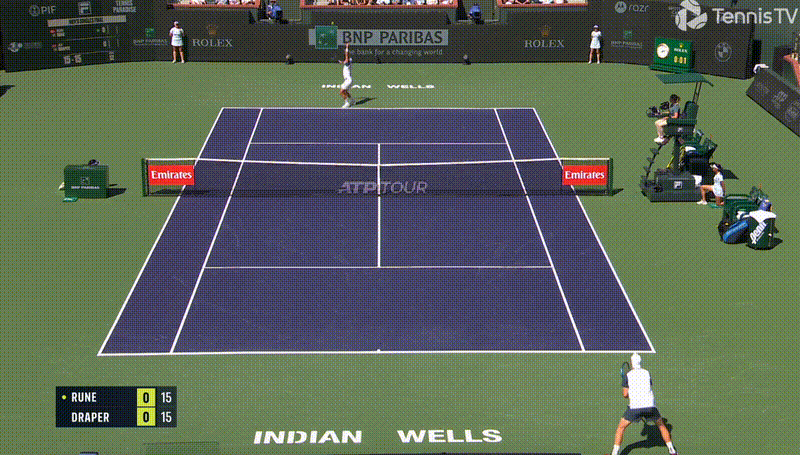

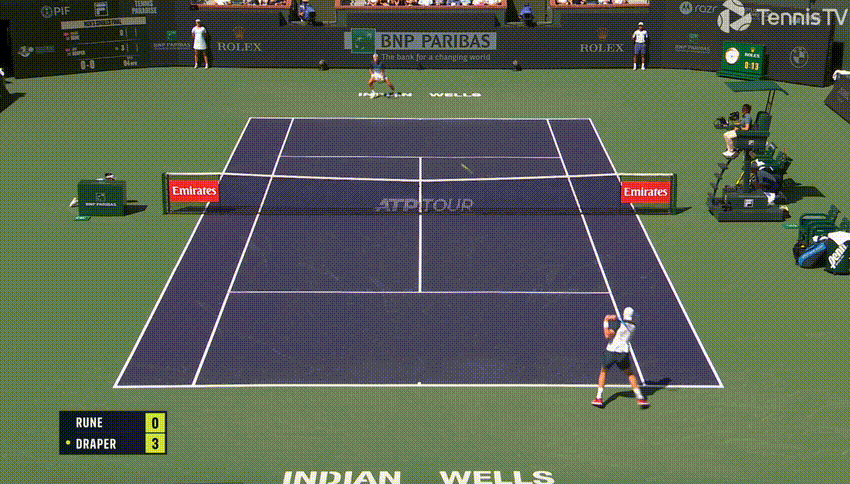



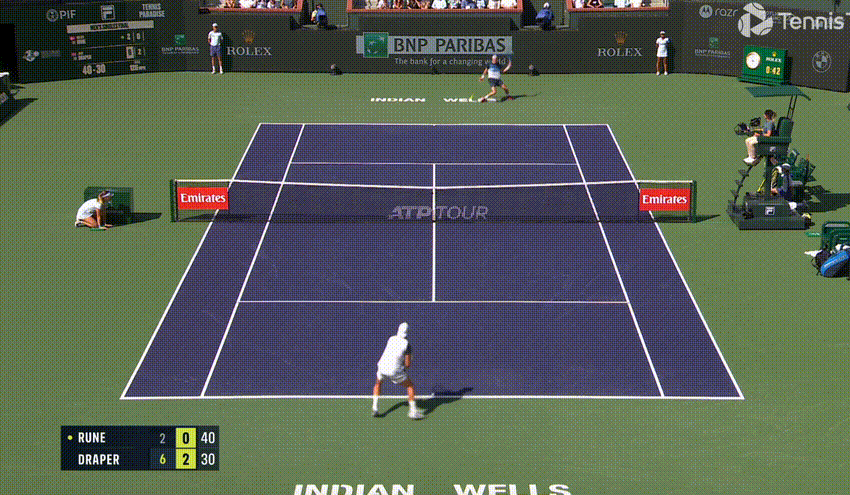
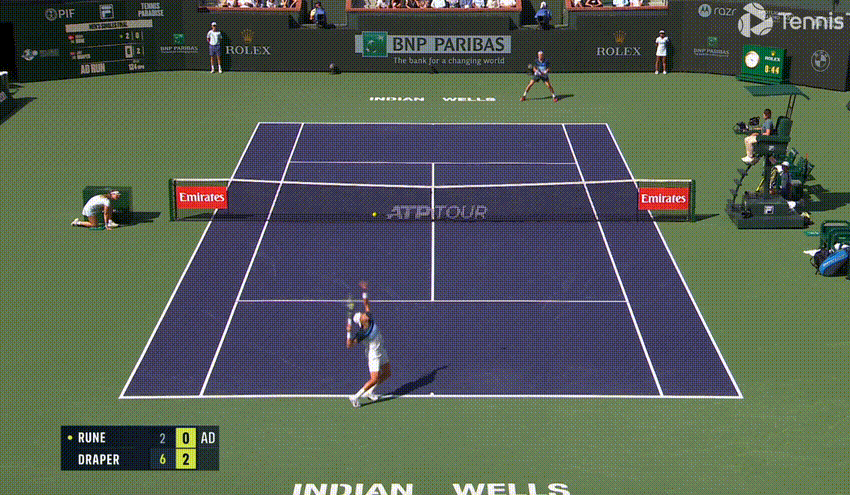





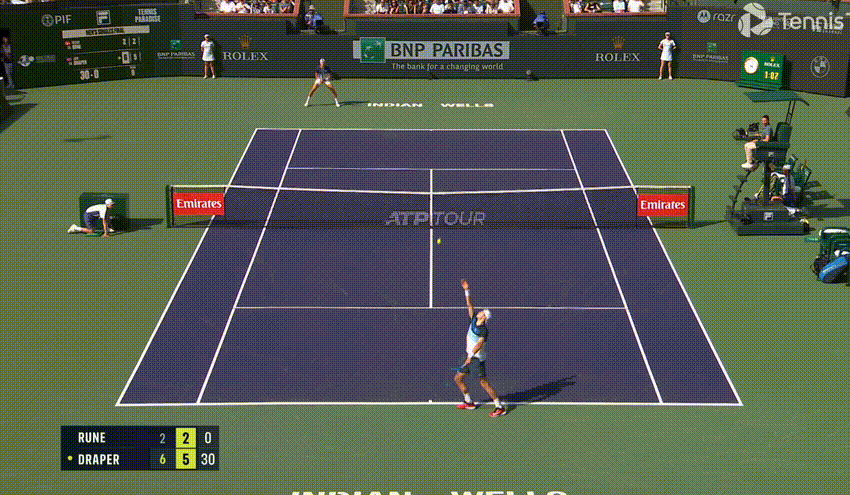

What really surprised me watching the match was Draper's strategy to attack Rune's forehand instead of putting the opponent's backhand under pressure, as you would expect in a "lefty vs righty" match. What are your thoughts on this tactic? I feel it came a bit short in this article, because it's so unusual, in my opinion. Apart from that, highest quality as always.
Hello Hugh, excellent article once again. In your opinion, how much of a problem is Rune's forehand and will it limit him in his career?